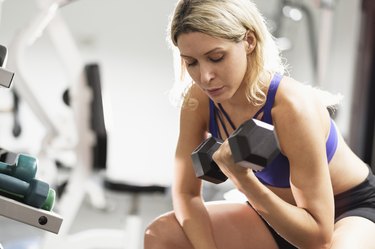
Big guns need lots of ammo, and the biceps curl will give you all the ammo you need to blow away the competition at the beach or gym. There are more muscles involved in the biceps curl than you may have thought. When your brachialis, deltoid, extensors and flexors are engaged and working in unison, they can all contribute — not just to a set of defined upper arms, but forearms and shoulders as well.
Tip
Your biceps brachii is the primary mover during biceps curls, but this exercise recruits a number of other muscles in your upper and lower arms.
Video of the Day
Biceps Brachii Muscle
Your biceps brachii muscle (long head) is attached to your shoulder blade (scapula) in two places. This twin configuration is reflected in the name biceps, meaning two heads. It follows down along your upper arm bone (humerus) and is inserted by a tendon on your lower arm bone (radius). When it contracts, your forearm is pulled up, with your arm bending at the elbow. Although this is the primary mover during biceps curls, it's far from the only muscle at work.
Video of the Day
Brachialis and Brachioradialis
Your brachialis muscle sits under the biceps brachii. It's a long muscle that flexes your elbow. It connects your upper arm bone (humerus) to the long forearm bone (ulna). Your brachioradialis muscle assists the brachialis with flexing your elbow and connects your humerus bone to the short lower arm bone known as the radius.
Your Deltoid Muscle
Your deltoid muscle is the rounded muscle that curves around the outer part of your shoulder and upper arm. The muscle forms a triangle shape, with the wide part of the triangle attaching to your shoulder blade (scapula) and your collarbone (clavicle) before stretching down to your humerus bone. The deltoid is responsible for several motions; in this case, it helps bring your upper arm forward if you aren't strictly isolating the elbow joint during your biceps curls.
Wrist Extensor Muscles
There are several extensor muscles that run along your forearm, connecting your upper arm bone (humerus) to your hand via your wrist. Among the wrist extensor muscles are the capri ulnaris; the digiti minimi (connected to your little finger); the digitorum; the indicis (which helps to extend your wrist); the pollicis brevis (connected to your thumb); and the retinaculum of the hand, which consists of a group of dense fibers in your wrist.
Wrist Flexor Muscles
Flexor muscles serve to decrease the angle between a pair of bones. The wrist flexor muscles used in a biceps curl exercise connect your elbow to your hand, running down your forearm. Your carpi radialis and carpi ulnaris flex your wrist up towards your forearm while you digitorum profundus and superficialis flexor muscles connect your forearm bone to the bones in your fingers, allowing them to curl.
Together, both your wrist flexors and your wrist extensors contract isometrically — in other words, without causing movement at the joint — to hold your wrist stable as you curl a dumbbell, barbell or another type of weight.
- ExRx.net: "Dumbbell Curl"
- InnerBody: "Biceps Brachii Muscle (Long Head)"
- InnerBody: "Brachialis Muscle"
- InnerBody: "Deltoid Muscle"
- InnerBody: "Muscles in the Hand and Wrist"
- InnerBody: "Flexor Carpi Radialis Muscle, Carpi Ulnaris Muscle, Digitorum Profundus Muscle and Digitorum Superficialis Muscle"
- MayoClinic.com: Video: Biceps Curl With Dumbbell